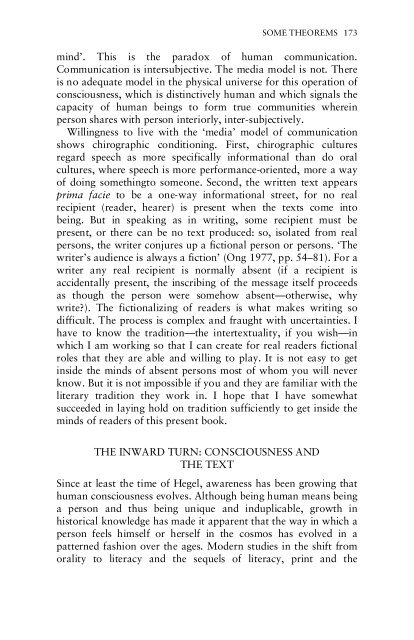Orality and Literacy: The Technologizing of the Word - Monoskop
Orality and Literacy: The Technologizing of the Word - Monoskop
Orality and Literacy: The Technologizing of the Word - Monoskop
Create successful ePaper yourself
Turn your PDF publications into a flip-book with our unique Google optimized e-Paper software.
SOME THEOREMS 173<br />
mind’. This is <strong>the</strong> paradox <strong>of</strong> human communication.<br />
Communication is intersubjective. <strong>The</strong> media model is not. <strong>The</strong>re<br />
is no adequate model in <strong>the</strong> physical universe for this operation <strong>of</strong><br />
consciousness, which is distinctively human <strong>and</strong> which signals <strong>the</strong><br />
capacity <strong>of</strong> human beings to form true communities wherein<br />
person shares with person interiorly, inter-subjectively.<br />
Willingness to live with <strong>the</strong> ‘media’ model <strong>of</strong> communication<br />
shows chirographic conditioning. First, chirographic cultures<br />
regard speech as more specifically informational than do oral<br />
cultures, where speech is more performance-oriented, more a way<br />
<strong>of</strong> doing somethingto someone. Second, <strong>the</strong> written text appears<br />
prima facie to be a one-way informational street, for no real<br />
recipient (reader, hearer) is present when <strong>the</strong> texts come into<br />
being. But in speaking as in writing, some recipient must be<br />
present, or <strong>the</strong>re can be no text produced: so, isolated from real<br />
persons, <strong>the</strong> writer conjures up a fictional person or persons. ‘<strong>The</strong><br />
writer’s audience is always a fiction’ (Ong 1977, pp. 54–81). For a<br />
writer any real recipient is normally absent (if a recipient is<br />
accidentally present, <strong>the</strong> inscribing <strong>of</strong> <strong>the</strong> message itself proceeds<br />
as though <strong>the</strong> person were somehow absent—o<strong>the</strong>rwise, why<br />
write?). <strong>The</strong> fictionalizing <strong>of</strong> readers is what makes writing so<br />
difficult. <strong>The</strong> process is complex <strong>and</strong> fraught with uncertainties. I<br />
have to know <strong>the</strong> tradition—<strong>the</strong> intertextuality, if you wish—in<br />
which I am working so that I can create for real readers fictional<br />
roles that <strong>the</strong>y are able <strong>and</strong> willing to play. It is not easy to get<br />
inside <strong>the</strong> minds <strong>of</strong> absent persons most <strong>of</strong> whom you will never<br />
know. But it is not impossible if you <strong>and</strong> <strong>the</strong>y are familiar with <strong>the</strong><br />
literary tradition <strong>the</strong>y work in. I hope that I have somewhat<br />
succeeded in laying hold on tradition sufficiently to get inside <strong>the</strong><br />
minds <strong>of</strong> readers <strong>of</strong> this present book.<br />
THE INWARD TURN: CONSCIOUSNESS AND<br />
THE TEXT<br />
Since at least <strong>the</strong> time <strong>of</strong> Hegel, awareness has been growing that<br />
human consciousness evolves. Although being human means being<br />
a person <strong>and</strong> thus being unique <strong>and</strong> induplicable, growth in<br />
historical knowledge has made it apparent that <strong>the</strong> way in which a<br />
person feels himself or herself in <strong>the</strong> cosmos has evolved in a<br />
patterned fashion over <strong>the</strong> ages. Modern studies in <strong>the</strong> shift from<br />
orality to literacy <strong>and</strong> <strong>the</strong> sequels <strong>of</strong> literacy, print <strong>and</strong> <strong>the</strong>

















